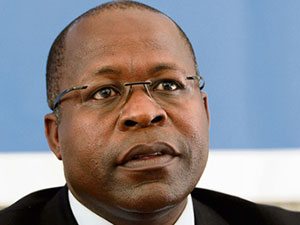
LONMIN has reduced its platinum sales target by as much as 12% to 650,000 ounces for its 2017 financial year in order to cut costs – which it said would remain under pressure – and to relieve strain on the over-supplied market.
The UK group said it had sold 735,747 platinum ounces in the financial year ended September 30. This was lower than its sales guidance of 700,000 oz owing to a smelter clean-up and metal release from improved processing technology.
However, it would reduce high cost production at its Newman and Hossy shafts over the next 18 months as it did not believe in over-supplying the market. “The platinum sector should do more to reduce supply. We have done our part,” said Lonmin’s CEO, Ben Magara in a conference call this morning.
Platinum sales were estimated to be between 650,000 and 680,000 oz for the 2017 financial year, the group said in commentary to its full-year figures in which it reported an underlying operating profit but a (reduced) share earning loss year-on-year.
Volatility in the platinum market was “a concern” in the short-term whilst the strengthening of the rand against the dollar would squeeze margins, Magara said.
Although there were signs of an improvement in investment demand for platinum, and whilst US president-elect Donald Trump’s infrastructure spend plans would be a benefit to platinum group metals (PGM), it was supply that comprised “the real threat”, he said.
“What I perceive to be the solution is the current low price which will continue to reduce South African production until customers are prepared to pay for new shafts and greenfields projects,” he said. “Thee will be upturn [in the market] but not now,” he added.
But there were no plans to further restructure the business as natural attrition at its Newman and Hossy shafts – which would wind down – was between 1,500 to 2,000 people per year. Lonmin currently employs 33,500 people after shedding 6,860 during the year under review mostly through voluntary retrenchments.
The company flirted with bankruptcy in 2015 following a decline in the basket price of PGMs. It raised $373m by means of a rights issue (net of fees), supported by the Public Investment Corporation (PIC) which became Lonmin’s largest shareholder with a 30% stake. It then refinanced its debt.
For the 2016 financial year the company reduced its loss per share to 137 cents from 3,437 cents in the previous year. Part of the loss was owing to an impairment charge of $335m owing to the weaker rhodium price long term outlook and the stronger rand in the second half.
It reported a $7m underlying operating profit compared to a $134m underlying operating loss in the previous year and said it had stabilised the business which was cash flow positive after capital expenditure.
Net cash increased to $173m as of September 30 (2015: $69m) while total liquidity, including bank debt, increased to $537m. It realised $24m in the year by removing its metal in process stock.
But Magara warned that costs would remain under pressure at between R10,800 to R11,300 per PGM oz. “Unit costs will remain under pressure until we see a sustained improvement in production throughput from mining,” he said.
CAPEX
Lonmin said it would increase capital expenditure to R1.8bn for its 2017 which compares to $1.26bn in the year under review, itself a reduction on revised guidance during the period of R1.5bn.
Analysts have questioned Lonmin’s capex plans which they think amounts to under-investment, and that could lead to production flexibility and cost problems in the future.
Magara said, however, that capex would be closely controlled. “We want to spend only from cash generated from our own activities or third party funding,” he said.
“There are innovative ways to reduce capex,” he said, adding that Lonmin’s purchase of Anglo American Platinum’s 42.5% stake in the Pandora Joint Venture which would defer between R2bn and R3bn in capex over the next five years.
Pandora represented shallow, high grade ore which could have accessed from the contiguous Saffy shaft and would therefore not require ore replacement at Saffy itself. Magara described the benefit of Pandora as “massive”.
Lonmin will pay between R400m and R1bn to Amplats by means of distributing 20% of Pandora’s free cash flow over the next six years. It would also allow Amplats full operational control of Lonmin’s Baobab concentrator for three years.
“Capital expenditure will be maintained at the minimum level required for the safe and efficient running of the
Group’s operating, as we continue to focus on our aim of being cash positive after capital expenditure,” said Lonmin.








